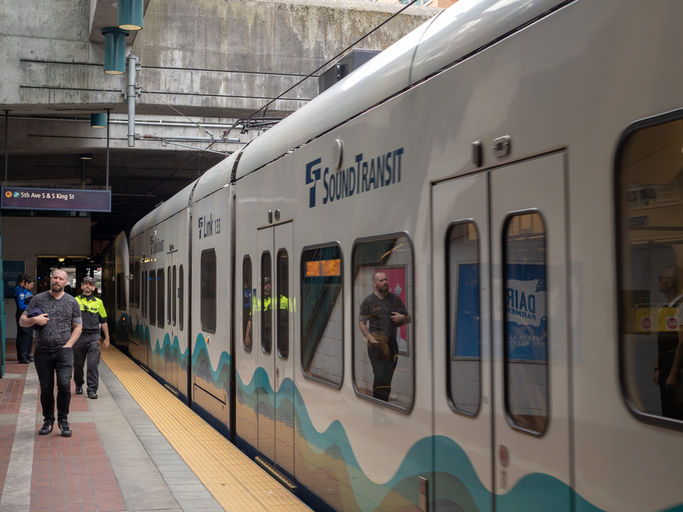Related Articles
Relevant Topics
-
Bellevue
-
Bureau of Transportation Statistics
-
Dow Constantine
-
Ed Murray
-
emergency medical services
-
Executive of King County, Washington
-
Gap Inc.
-
Greg Nickels
-
King County Council
-
Portland
-
project
-
Seattle
-
Seattle City Council
-
Seattle Department of Transportation
-
Sound Transit
-
The Seattle Times
-
United States Department of Transportation
-
Washington Policy Center
-
Washington State Department of Transportation
-
Zillow
- Mayor Ed Murray and city leaders want a special $930 million property tax levy to increase transportation spending. The new property tax would nearly triple the tax burden of the levy it would replace.
- The tax proposal comes at a time when city and county officials have increased the tax burden on the public. Examples include: A $696 million, six-year EMS levy; a $396 million property tax for parks; $45 million per year in sales taxes and car fees in Seattle for transit; a $235 million property tax increase for early learning programs.
- The proposal would increase regressive taxes and fall hardest on the poor, working families and elderly people living on fixed incomes. It would increase the cost of living in Seattle, reduce social and economic equity and widen the income gap in the city. The proposal would add $315 to the yearly tax burden on the owner of a median-priced Seattle home.
- The plan would increase congestion in the future, even with the billions of new dollars that will be spent on Move Seattle and light rail expansion.
- Much of SDOT’s budget is devoted to payroll, personnel and benefits.
- Based on the failures of the 2006 Bridging the Gap program it is likely the Move Seattle plan would not deliver as promised.
- Under Move Seattle, core city services would continue to rely on temporary special taxes, while increasing levels of regular tax revenue is spent on other, less popular programs.
- Officials should pause and design a street-repair program that is less costly to Seattle families, more realistic and focused, and more likely to be carried out as promised.
Introduction
The Seattle Department of Transportation provides a vital public service to the people of Seattle and is responsible for maintaining and preserving the city’s bridges, streets, arterials, sidewalks and bike paths. In 2006, Mayor Greg Nickels and city officials sought a nine-year, $365 million property tax increase called Bridging the Gap, the largest in city history at the time, which they said they would use to reduce the city’s street maintenance backlog, boost transit services and expand bike paths.
The special Bridging the Gap property tax ends this year. Seattle homeowners and other property owners are on track to have paid the full $365 million city officials sought, although many of the public services that were promised in 2006 were not provided. The failed promises were part of Washington Policy Center’s in-depth review of the Bridging the Gap program.
This year, Mayor Ed Murray and the Seattle City Council say they want a nine-year, $930 million property tax levy, to expand the Bridging the Gap program. The new nine-year levy would nearly triple the tax burden of the levy it would replace, and is the most expensive Seattle property tax levy ever proposed. City officials want Seattle voters to agree to the larger levy in the November general election.
The 2015 General Election Voters’ Guide explains how city officials promise to use the new revenue, if residents approve increasing the property tax burden on working families in Seattle:
“PROPOSITION NO. 1
The City of Seattle’s Proposition 1 concerns replacing funding for citywide transportation maintenance and improvements. If approved, this proposition would replace an expiring levy and would fund bridge seismic upgrades, transit corridor and light rail access projects, pedestrian and bicycle safety projects, synchronized traffic signals, street maintenance and repair, freight projects, and neighborhood street projects.
It authorizes regular property taxes above RCW 84.55 limits, allowing maximum collections of $95,000,000 in 2016 and $930,000,000 over nine years. The 2016 total regular tax limit would be $3.60/$1,000 assessed value, including approximately $0.62/$1,000 assessed value in additional taxes. Should this levy be approved?”
The rising tax burden
If imposed, the property tax levy would increase the cost of housing in the city at a time Mayor Murray calls the “worst housing affordability crisis in decades.” According to the real estate database company Zillow, the median home value in Seattle is $508,000.
If voters approve the levy, the owner of a median-priced home would pay an additional $315 every year in property taxes, or about $2,800 over the life of the levy. Renters would likely pay the levy in the form of higher monthly rents, as building owners shift the tax burden to tenants.
The property tax increase proposal comes at a time when city and county officials have increased the tax burden on the public. Recent examples include: A $696 million, six-year Emergency Medical Services property tax levy; a $396 million, six-year property tax for county parks; a $45 million annual increase in regressive sales taxes and car fees in Seattle for transit and a $235 million, six-year property tax increase in Seattle for early learning programs.
In all, people in Seattle are paying hundreds of millions every year in added taxes, fees and special levies, in addition to the base property tax and other regular taxes city officials impose on residents.
More tax increases are expected. Local officials plan to propose other levies and fee increases in the near future. King County Executive Dow Constantine and the majority of the King County Council want to raise the property tax paid by county residents by $392 million over six years, to create another early learning program. His levy proposal will also appear on the November ballot.
Sound Transit officials say that next year they want $15 billion more in regressive sales taxes, car tab fees and property taxes over 15 years to build more light rail, and Mayor Murray indicates that he wants to double Seattle’s current, $145 million housing levy in 2016.
Nearly all these proposals involve increases in regressive taxation, with the financial burden falling hardest on the poor, working families and elderly people living on fixed incomes. The rise in regressive taxes causes little disruption in the lives of wealthy households, but it does have a disproportionate impact on low-income families. The result is a rise in the cost of living in Seattle, a reduction in social and economic equality, and a widening of the income gap in the city.
Slower travel times and worsening traffic congestion
If voters approve of higher taxes, Seattle officials say they plan to spend $930 million in three areas: $207 million in spending on bike and pedestrian walkways, $420 million on maintenance and repair, and $303 million on congestion relief. Yet despite the planned record-levels of spending, travel may get tougher for many who drive around Seattle.
Seattle officials say their plan would reduce congestion, yet their recent comprehensive plan shows travel times would likely increase in the future, even with billions in new dollars spent on Move Seattle and future light rail expansion.
As reported in The Seattle Times, Seattle’s plan would increase travel times by 11 minutes on average by 2035, as “single-occupant vehicle usage will decline by just 3 to 4 percent over the next 20 years.” Instead of improving travel times, Seattle officials have defined congestion relief programs to, “enhance transportation choices throughout the network.”
A policy of enhancing “transportation choices” is not the same as providing congestion relief. The shift is an admission by Seattle leaders that they expect traffic congestion and travel times to get worse under their plan.
The failures of Bridging the Gap promises
In 2006, Mayor Nickels and Seattle officials promised they would cut the street maintenance backlog in half and rehabilitate 360 lane miles of arterial streets. During the campaign, signs promising to “Fix This Street” proliferated throughout the city. Residents expected that, through the largest tax levy increase to date, the Bridging the Gap program would repair the city’s road and arterials, as officials outlined.
Today, Seattle officials report they have paved only 225 lane miles. Instead of cutting the maintenance backlog as promised, Seattle’s arterial street backlog has more than tripled, from $300 million in 2006 to $970 million today.
Looking ahead, Seattle officials indicate their arterial maintenance backlog will continue to grow under the proposed Move Seattle levy. In 2006, city leaders said that about 1,000 lane miles of arterial streets needed to be paved to catch up with the maintenance backlog.
But the $930 million Move Seattle plan would provide paving for only 180 lane miles of arterial streets over nine years, and fund temporary “spot paving” for another 70 lane miles. This means that by 2026, officials will have paved fewer than 600 lane miles of arterial streets, or 40 percent less than what they report is needed to eliminate the backlog.
This level of public service, however, would only be delivered if Mayor Murray and other city officials carry out their plan as promised. Based on the failures of the 2006 Bridging the Gap program, coupled with recent cost overruns on projects like the Seattle Seawall, it is entirely possible the Move Seattle plan will not perform as currently expected.
In other words, the public would pay more to receive less service, even if the full plan is carried out. In 2006, Seattle officials said they would need $1.1 billion in property taxes over 20 years to catch up the maintenance backlog and fund other transportation programs. Yet the $930 million levy, in addition to the expiring $365 million Bridging the Gap levy, would cost the public nearly $1.3 billion in property taxes, 18 percent more than originally estimated, without eliminating the maintenance backlog.
Department of Transportation budget – the shift to temporary revenue
Maintaining public sidewalks and streets is a core service of local government. The public road network is not an “extra,” it is an essential part of any urban community. Yet the Move Seattle tax program would continue the practice of using special levy dollars for routine maintenance, a management approach started by Mayor Nickels with Bridging the Gap.
This management trend is reflected in the shifting priorities in the regular city budget. By 2015, city officials had increased general fund spending on other government programs by 38 percent compared to 2006 service levels, but they increased general fund spending on transportation services by less than one percent. This shift would continue under Move Seattle – greater reliance on temporary special taxes to pay for basic services, while regular tax revenue is spent on other, less popular programs.
The authorizing legislation calls for a minimum of $40 million of general fund appropriations every year of the levy, about the same as the last nine years. While general fund appropriations have not changed much, the Seattle Department of Transportation (SDOT) budget has grown 172 percent over 2006 service levels, from $158 million to $429 million.
Much of SDOT’s budget is devoted to payroll, personnel and benefits. Salaries and wages at SDOT are substantially higher than other local transportation agencies. For example, out of 730 SDOT employees last year, 148 made over $100,000, which is 20 percent, or one out of every five employees. At the Washington State Department of Transportation, only six percent of workers received compensation over $100,000 last year. Portland’s Bureau of Transportation, PBOT, had 795 employees last year, yet only 30 employees made $100,000 or more, or four percent of the workforce.
More than half of workers at SDOT were paid $75,000 or more. At the state agency, WSDOT, about 19 percent of employees made over $75,000. In Portland, about 23 percent of PBOT employees received compensation above $75,000.
As noted, the regressive tax increases under Move Seattle would have a disproportionate impact on working and low-income families. A portion of the new funding would be devoted to continuing the upward trend in compensation for city executives, managers and other employees, contributing to the growing income gap in the city. As higher city taxes reduce household incomes, public-sector salaries would continue to increase, raising concerns about equity and social justice.
Conclusion
The continued reliance on special levies to fund core city services is concerning. If Move Seattle does not pass, voters are told that core arterials and neighborhood streets would continue to deteriorate. This places artificial pressure on voters to accept tax increases, even though travel times would get worse under Move Seattle.
Instead, public officials should take a time-out and redesign public services so they provide real and noticeable congestion relief for all users of the transportation system, including drivers. Since driving is the preferred option for most people, and is the only practical option for many elderly people, people with two or more jobs, and families with children, improving travel times on city streets is a value-added public service city officials could provide.
Some of the limited programs, if carried out, would help the public under Move Seattle. Under the plan, officials would spend $30 million, or about three percent of funding on traffic signal timing improvements and intelligent transportation systems. Similar upgrades have shown promise in Bellevue and in other cities around the country. In addition, seismically reinforcing bridges is a good step towards keeping the system safe and in a state of good repair.
However, the regressive tax increases city officials want would lead to greater income inequality and would make the income gap worse without reducing congestion in the city. Many working families have not benefited from the slow economic recovery, and property taxes are not based on one’s ability to pay. Due to the size of the tax increase, one The Seattle Times editorial board called “breathtaking,” officials should pause and design a proposed street-repair program that is less costly to Seattle families, more realistic, and more likely to be carried out as promised.




